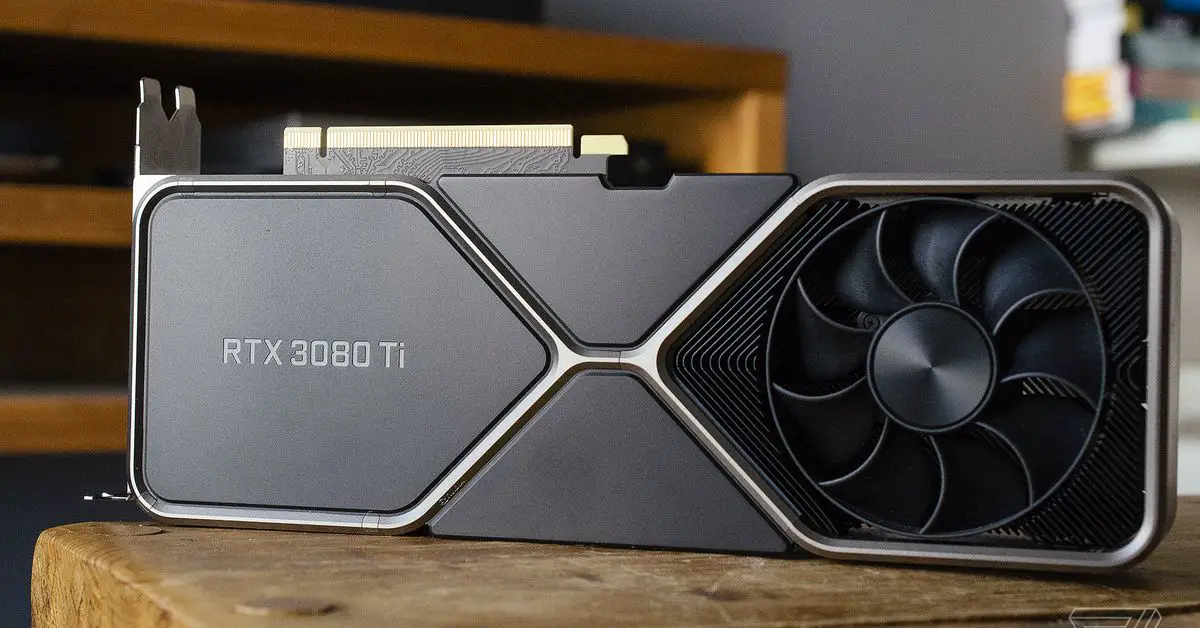High-end and expensive, the GeForce RTX 3080 Ti is a gaming graphics card with characteristics similar to those of the GeForce RTX 3090. This new iteration from Nvidia’s Amp generation has strong ambitions in 4K.
Our Review
Presentation
Nvidia completes its high-end GeForce RTX 30 offering with a GeForce RTX 3080 Ti which has more hooks with the GeForce RTX 3090 than with the GeForce RTX 3080 . Revolution point on this model which uses the Ampere architecture of the rest of the series but whose GA102 GPU has an unprecedented distribution of computing units. Intended for players wishing to indulge their passion without compromise on a 4K monitor, it is announced at a price of $1199 in its Founders Edition version – and often much more for custom models.
The technical point
Here again we find Ampere, the architecture of the other GeForce RTX 30s. For more details on this subject, we refer you to our dedicated file:
To shape its GeForce RTX 3080 Ti, Nvidia opted for a GA102-225 chip very similar to the GA102-300 of the GeForce RTX 3090. There are 10,240 classical computing units (CUDA Cores), but also 320 IA computing units (Tensor Cores) and 80 units dedicated to raytracing (RT Cores); as much to say that the difference with the GeForce RTX 3090 is rather meager (10496/328/82). This set is accompanied by 112 rendering units and 320 blocks for textures.
This chip inherits operating frequencies close to those of the rest of the series. The base frequency is 1365 MHz and the average GPU Boost frequency is given for 1665 MHz. Nothing new at this level, nor at the level of power consumption where the GeForce RTX 3080 Ti is given for 350 watts, like the superior model.
The major difference with the GeForce RTX 3090 is to be found in the graphics memory side. If we find the 384-bit bus and GDDR6X (at 2375 MHz however), Nvidia has halved the quantity, the GeForce RTX 3080 Ti being satisfied with 12 GB. In a strictly gaming framework , this will not change much – if that’s nothing -, the 24 GB of the RTX 3090 being especially useful for rendering large 3D projects. Incidentally, Nvidia has abandoned the operation of NVlink here, making it impossible to use several RTX 3080 Ti in parallel.
A body of GeForce RTX 3080
If the engine is very similar to that of the GeForce RTX 3090, the cover is for its part taken from the GeForce RTX 3080 . Point of innovation at this level, the graphics card takes again feature for feature the cooling system of the lower model. We thus find a metal casing with a very neat finish and a dolphin-type ventilation system with two fans positioned so as to create a current of air perpendicular to the graphics card.
The power supply passes again through the 12-pin connector specific to Nvidia. An adapter is provided to connect two conventional 8-pin PCIe connectors to it. A solution that is still not very elegant.
Finally, the card has four video outputs: three DisplayPort 1.4 and one HDMI 2.1. The latter is able to output an 8K HDR signal.
Noise
At the risk of repeating ourselves from one test to another, remember that Nvidia’s original cooling system requires the use of a properly ventilated case. The heat emitted by the card is ventilated directly in the axis of the RAM and the processor. To prevent the CPU from taking too many degrees – up to 5 ° C according to our measurements – and from entering into throttling (reduction of the frequency when the temperature is high), it is preferable to use a CPU cooling system at AiO type water, for example. Otherwise, the ventilation of the housing must not be neglected.
Completely inaudible at rest – the ventilation cuts out – the GeForce RTX 3080 Ti is heard in video games. Unsurprisingly, with 30 watts more to manage than on a conventional GeForce RTX 3080, the cooling system logically rises higher in the towers. The breath of the fans is thus clearly audible, but it remains tolerable. The graphics chip is maintained at a temperature of 82 ° C, a higher value than on the rest of the series.
Consumption
No surprises regarding power consumption. The graphics card operates as instructed by Nvidia. As the technical specifications report, it is indeed 350 watts that are drawn on average by the single card. Suffice to say that it is necessary to properly size the power supply unit of the computer; especially since we were able to measure brief spikes at 375 watts, which is roughly the limit of the PCIe standard. However, like the rest of the series, we lose a few dozen watts on some games, especially those that use DLSS.
While power consumption is high in absolute terms, energy efficiency is, on the other hand, still very good. In short, a graphics card that is energy intensive, certainly, but very fast in games, as we will see.
Performance in games
As usual, we first undertook to analyze the behavior of the GPU frequency once the graphics card was housed in a case. In 4K, on our benchmark test, we noted a maximum frequency of 1950 MHz and an average of 1710 MHz. Slightly lower values than those obtained by the GeForce RTX 3090.
We conducted our usual series of tests on classic rendering games. Unsurprisingly, this panel allows the GeForce RTX 3080 Ti to display average performance identical to that of the GeForce RTX 3090 and to beat the GeForce RTX 3080 by around 10% in 4K and 6% in 1440p. Our test computer can nevertheless qualify as dated, with a Core i7-8700K which acts as a bottleneck.
We then conducted a second round of testing on a new test procedure. For this, we have changed everything at the configuration level. This time it revolves around a Ryzen 9 5900X accompanied by 32 GB of Corsair Dominator Platinum DDR4-3600 RAM. Everything is housed in a Corsair 4000D Airflow case. We reviewed 11 games, some running both classic render and raytraced, while others may have had a third round of testing with DLSS.
The verdict is quite interesting with a configuration less limited by the processor: in 4K, on games run in classic rendering, the GeForce RTX 3080 Ti is 4% slower on average than the GeForce RTX 3090. This allows it to be once again 10% ahead of the GeForce RTX 3080. With active raytracing, the difference is 1% compared to the RTX 3090 and 16% compared to the RTX 3080. Finally, the activation of DLSS does not change the situation and results in a delay of 3% on average over the RTX 3090 and an 11% lead over the RTX 3080.
In any case, we note a significant advance over the Radeon RX 6900 XT from AMD. This lead is very important in raytracing (57%) and is established at 8% on average in rasterization . Note however that some titles ported from their console versions – with a GPU similar to that of the Radeon – behave better on the Radeon than on the GeForce; we are thinking in particular of Assassin’s Creed Valhalla or Outriders . In the second case, however, it is possible to activate DLSS to obtain a nice increase in the image rate, without the graphics quality being impacted.
Finally
The GeForce RTX 3080 Ti is undeniably a great graphics card for gamers with 4K monitors who want to push all of the gaming graphics sliders to their maximum. Games with raytraced rendering also run smoothly and DLSS 2.0 does its job well, sometimes adding dozens of frames per second without affecting the quality of the rendering.
A great success in terms of performance and which is accompanied by a design product certainly already seen with the GeForce RTX 3080, but which still enjoys such good finishes. However, it will be necessary to deal with a fairly high power consumption and, above all, a price that makes it inaccessible to many players.
Because at $1199 in this Founders Edition version, the GeForce RTX 3080 Ti remains a luxury product, with no real competition when the games are executed in raytracing. A high price that certainly does not give it a good performance / price ratio when compared to its inferior models – the RTX 3080 Founders Edition is at $719, or about 35% cheaper for performance just down. 10%. On the AMD side, only the Radeon RX 6900 XT sometimes manages to rise to the height of this elitist model – and sometimes even exceed it -, but only on games with classic rendering.
There remains the uncertainty of availability. Nvidia promises to have done what is necessary in terms of production capacity and reduction of cryptocurrency mining restrictions, so as not to suffer the same shortage as in the rest of the series.
An elite model for wealthy gamers who don’t care about the price / performance ratio, the GeForce RTX 3080 Ti is certainly a wise choice. The performances are of high level, in the classic games as in raytracing. The icing on the cake, DLSS 2.0 accompanies this model admirably to increase the speed even higher in the rare very sluggish games, such as Cyberpunk 2077 . Top of the range from every point of view.

